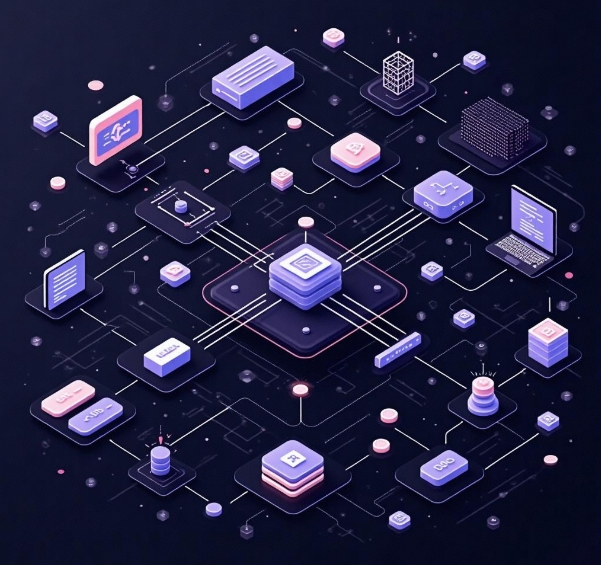Building a Decentralized Application (DApp) from Scratch – Web3 Development Practice
- latest articles
- 1.DApp Development & Customization: Merging Diverse Market Needs with User Experience 2.Analysis of the Core Technical System in DApp Project Development 3.How to achieve cross-chain interoperability in Web3 projects? 4.How does the tokenization of points reconstruct the e-commerce ecosystem? 5.How to Set and Track Data Metrics for a Points Mall? 6.What is DApp Development? Core Concepts and Technical Analysis 7.Inventory of commonly used Web3 development tools and usage tips 8.Development of a Distribution System Integrated with Social E-commerce 9.Six Key Steps for Businesses to Build a Points Mall System 10.What is DApp Development? A Comprehensive Guide from Concept to Implementation
- Popular Articles
- 1.Future Trends and Technology Predictions for APP Development in 2025 2.Analysis of the DeFi Ecosystem: How Developers Can Participate in Decentralized Finance Innovation 3.From Zero to One: How PI Mall Revolutionizes the Traditional E-commerce Model 4.DAPP Development | Best Practices for Professional Customization and Rapid Launch 5.Recommended by the Web3 developer community: the most noteworthy forums and resources 6.From Cloud Computing to Computing Power Leasing: Building a Flexible and Scalable Computing Resource Platform 7.How to Develop a Successful Douyin Mini Program: Technical Architecture and Best Practices 8.Shared Bike System APP: The Convenient Choice in the Era of Smart Travel 9.How to Create a Successful Dating App: From Needs Analysis to User Experience Design 10.From Design to Development: The Complete Process of Bringing an APP Idea to Life
In recent years, the rapid development of blockchain technology has propelled the rise of Web3, which is regarded as the core concept for building the next generation of the internet. The core idea of Web3 is decentralization, aiming to eliminate centralized institutions in the traditional internet and return control of data and applications to users. In the Web3 ecosystem, decentralized applications (DApps) are a crucial component. DApps not only change the relationship between users and applications but also provide developers with a more open, transparent, and decentralized development platform.
However, despite the immense potential of DApps, building one from scratch remains a challenge for many developers. This article will systematically guide readers through the entire process of building a DApp from the ground up, including the basics of DApps, selecting development tools, and constructing the development workflow. Whether you are a beginner in blockchain technology or an experienced developer, you will gain practical guidance from this.
Chapter 1: The Concept and Core Components of DApps
1.1 Overview of DApps
Decentralized applications (DApps) are applications built using blockchain technology that do not rely on centralized servers but operate on a decentralized network. Traditional applications typically rely on centralized servers to host and process user requests, whereas DApps execute logic and store data on the blockchain through smart contracts. As a result, DApps are characterized by decentralization, transparency, and immutability, ensuring the security and privacy of data and transactions.
Compared to traditional applications, DApps have several unique features. First, the frontend of a DApp can still be developed using common web technologies such as HTML, CSS, and JavaScript, but its backend runs on the blockchain via smart contracts. Smart contracts are self-executing code that defines the business logic of the DApp and ensures operational transparency and immutability through the blockchain's consensus mechanism. Second, users need to use a blockchain wallet (such as MetaMask) to manage their identity and assets and interact with the DApp.
1.2 Core Components of DApps
DApps typically consist of three main components:
Frontend: The user interface of the DApp, usually built using traditional web development technologies like HTML, CSS, and JavaScript. The frontend interacts with the blockchain's smart contracts, displays data, and calls the functions of the smart contracts.
Smart Contracts: The "backend" logic of the DApp, running on the blockchain network. Smart contracts are decentralized, self-executing protocols that ensure the transparency and immutability of the DApp. They define business logic, such as transaction rules and asset transfers.
Blockchain Network: The underlying infrastructure of the DApp, providing decentralized data storage and computational capabilities. Currently, Ethereum is the most popular blockchain platform, supporting the development and execution of smart contracts.
Wallet: DApps require users to use a blockchain wallet for identity verification, transaction signing, and other operations. Wallets like MetaMask can connect with the frontend DApp, allowing users to manage their private keys and digital assets.
Chapter 2: Setting Up the Development Environment
Before developing a DApp, it is essential to set up a suitable development environment, including selecting development frameworks, blockchain nodes, and wallet tools. A proper development environment can improve efficiency and reduce unnecessary errors.
2.1 Choosing Development Tools
Blockchain Platform: Ethereum is currently the most popular platform for DApp development, offering robust smart contract functionality and extensive community support. For beginners, it is advisable to use Ethereum's test networks (such as Rinkeby or Ropsten) for development and testing. Test networks provide free virtual Ether, allowing developers to test and debug smart contracts without risk.
Development Framework: Truffle is a commonly used framework for Ethereum smart contract development, supporting the writing, compilation, migration, and testing of smart contracts. Truffle provides a complete set of development tools to simplify the smart contract development process. Additionally, Hardhat is another popular Ethereum development framework focused on more efficient development and testing.
Wallet Tools: To interact with the blockchain, developers need wallet tools like MetaMask. MetaMask is a browser extension that enables interaction with frontend DApps, manages users' digital assets, and handles signature authentication.
Blockchain Simulator: Ganache is a local Ethereum blockchain simulator that allows developers to run an Ethereum network locally for debugging and testing. With Ganache, developers can test smart contracts without connecting to a real blockchain.
2.2 Configuring the Development Environment
Install Node.js: Node.js is the runtime environment for JavaScript, and DApp development relies on it to run related development tools and frameworks.
Install Truffle: Truffle is a powerful development framework that helps developers write, deploy, and manage smart contracts. Install Truffle via the command line and initialize a new project.
Install Ganache: Ganache is a blockchain simulator that provides a private Ethereum network locally for developers to test smart contracts.
Configure MetaMask: MetaMask is a browser wallet that supports users in managing Ethereum accounts and digital assets. During DApp development, MetaMask interacts with the frontend to help users sign transactions and authenticate their identity.
Chapter 3: Smart Contract Development
Smart contracts are the core of DApps, as all business logic is implemented through them. Once deployed to the blockchain, smart contracts cannot be altered, so it is crucial to write them carefully to ensure correctness and security.
3.1 Writing Smart Contracts
Smart contracts are typically written in Solidity, a programming language designed specifically for the Ethereum platform. Its syntax is similar to JavaScript but includes additional blockchain-specific features, such as handling transactions and managing accounts.
A simple smart contract might include functions like token issuance and asset transfers. For example, an ERC-20 token contract would define the token's name, symbol, total supply, and implement transfer functionality. Developers can write complex contracts based on DApp requirements, enabling features like voting systems, decentralized finance (DeFi) protocols, and NFT marketplaces.
3.2 Deploying Smart Contracts
After writing a smart contract, the next step is to deploy it to the Ethereum blockchain. Deployment requires a blockchain node. Developers can choose to deploy to a test network to ensure the stability and security of the smart contract. Using tools like Truffle or Hardhat, developers can easily deploy smart contracts to the Ethereum network and obtain the contract address for frontend interaction.
Chapter 4: Frontend Development and Interaction
The frontend of a DApp is the interface through which users interact with the blockchain. Developers need to build a user-friendly and intuitive UI to allow users to easily utilize the DApp's features. The frontend can be developed using traditional web technologies like HTML, CSS, and JavaScript. Additionally, the frontend must interact with the blockchain using libraries like Web3.js to call smart contract functions.
4.1 User Identity Management
User identity in DApps is managed by blockchain wallets like MetaMask. When users access a DApp, the frontend needs to connect to MetaMask and request user authorization. Users can manage their accounts, sign transactions, and check balances through MetaMask.
4.2 Interacting with Smart Contracts
The frontend interacts with smart contracts using JavaScript libraries like Web3.js or Ethers.js. Web3.js can connect to the Ethereum network, send transaction requests, and read on-chain data. For example, the frontend can call the smart contract's balanceOf method to retrieve a user's token balance or call the transfer method to execute token transfers.
4.3 Deploying the Frontend
The completed DApp frontend can be deployed using traditional web hosting platforms like Netlify or Vercel. These platforms support hosting static files built from frontend frameworks like React or Vue, greatly simplifying the DApp deployment process.
Chapter 5: Testing and Launching the DApp
After completing DApp development, the next step is comprehensive testing and deployment.
5.1 Testing
DApp testing includes both the frontend and smart contracts. Smart contracts need multiple rounds of testing on test networks to ensure the correctness and security of their logic. The frontend requires functional testing to ensure a smooth user experience and error-free interactions.
5.2 Launching
After testing, developers can choose to deploy the DApp to the mainnet or continue operating on a test network. Once launched, users can access the DApp via a browser and interact with the blockchain.
Conclusion
Building a decentralized application (DApp) is not an overnight process, but with the maturation of Web3 technology, developers can more easily create and deploy decentralized applications. Through this article, we have explored the basic concepts of DApps, the selection of development tools, and the construction of the development workflow. As blockchain technology continues to innovate, decentralized applications will become a vital part of the future internet, offering users a more free, secure, and transparent online experience.
-

DApp Development & Customization: Merging Diverse Market Needs with User Experience
As blockchain technology matures and becomes more widespread, decentralized appl···
-

Analysis of the Core Technical System in DApp Project Development
With the rapid development of blockchain technology, decentralized applications ···
-

What is DApp Development? Core Concepts and Technical Analysis
With the rapid development of blockchain technology, decentralized applications ···

 Blockchain
Blockchain












